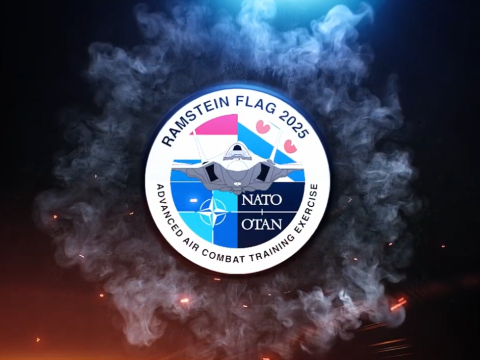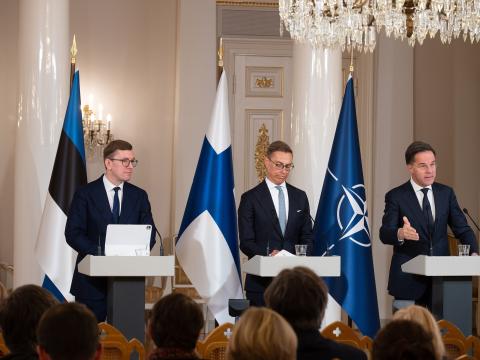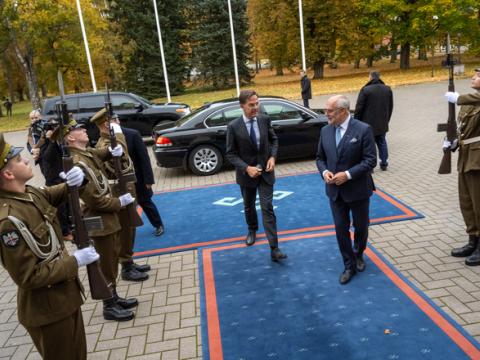NATO Treads Carefully Toward a Digital Future
NATO is moving into the digital realm deliberately, avoiding a headlong rush into new technologies, even though it is committed to modernizing its communications and information systems on a large scale. The alliance is incorporating new information technologies without breaking either the bank or speed records by tapping the expertise of others to bring digital benefits to the organization and its forces.
This approach helps ensure that both obtain proven technologies at very low risk. But NATO is reaching out concurrently to nontraditional sources of expertise and innovation to help guide it well into the digital future. This includes determining which technologies to exploit as well as developing more capabilities down the road.
“Leading NATO’s digital endeavor is my top priority,” declares Kevin J. Scheid, general manager of the NATO Communications and Information (NCI) Agency. Two major projects will reach fruition soon, and they will complement each other on both the organizational side and the operational side.
In terms of technology implementation, NATO trails industry by about five years—“and that’s not a bad thing,” Scheid offers. NATO is behind in the cloud, artificial intelligence, machine learning and big data, to name a few areas. The advantage of this approach is that NATO “reaps the benefits of other people’s mistakes,” he declares. The U.S. military and industry, along with those of other advanced Western nations, make the mistakes and work the bugs out of new technologies, after which NATO chooses what will perform best. Consequently, the cash-strapped multinational alliance reaps the best capabilities without spending money on costly technology development.
“The way we procure systems and the way we develop new capabilities, we’re slow and methodical,” Scheid explains. “I see it as a good business practice for NATO because we don’t have a lot of money to waste on experiments. We want the biggest bang for the euro, and to let others work the bugs out is a smart strategy.”
For example, NATO is moving to cloud technologies in ways that the United States did more than five years ago. The alliance is reducing data centers and, accordingly, cutting cyber vulnerabilities. This strategy proved effective in experiences across the Atlantic, he notes. NATO ultimately might provide secure cloud services to member nations that cannot afford their own sophisticated cloud infrastructures, Scheid suggests.
And NATO only now is beginning to think about big data. This entails defining the data that the alliance collects, how it is used for decision making and how artificial intelligence can help the data exploitation process. Those determinations lie five years in the future, Scheid says.
But NATO is not waiting for all its digital upgrades to begin its transformation. A variety of high-priority projects are turning the alliance into a more digital organization, Scheid says. These efforts will transform the infrastructure, applications, business processes and development of the NATO cloud. The goal is to move toward a more digital environment, both for alliance forces and for the organization.
NATO’s network, which grew out of the Afghan Mission Network, features a variety of applications developed with industry, Scheid notes. These include a NATO common operating picture and collaborative tools, along with applications that help manage large volumes of video sent by drones.
The move into a new NATO headquarters represents “an uplift in the collaborative communication tools” the alliance will have, he adds. The official move began last month and is expected to be complete before the NATO summit, which will be held in the new building in July. “We are becoming a much more mobile IT [information technology] workforce with laptops and cellphones. While this all sounds rather normal to someone in industry today, for NATO in a secure environment, this is a huge uplift in headquarters’ capabilities.”
On the heels of this move will be a similar uplift in the capabilities of the alliance’s two military commands—Allied Command Operations in Mons, Belgium, and Allied Command Transformation in Norfolk, Virginia. The IT Modernization Program will join the headquarters entity to form a single business network and a military operations network within the next 36 months, Scheid allows. Security levels will be either NATO restricted or Secret.
Hindering NATO modernization efforts are antiquated procurement and acquisition practices. “You don’t want to just give new kit to an organization that maintains its 1970s business practices,” Scheid offers. “You want to change the way they do business to reap the full benefits of that.”
The alliance is using the same procurement practices it employed more than 30 years ago, when it was largely buying runways, hangars and pipelines, Scheid relates. NATO has not updated its acquisition rules to accommodate software-intensive, complex information technology programs and projects.
And, as with many other military-oriented organizations, the alliance is plagued by a risk-averse mentality to managing complex projects. “We treat these complex IT projects the way we would procure a hangar, which has very little risk,” Scheid declares. “But if you think there is nearly zero risk, and your business processes don’t build in or assume more risk, then you’re stuck with cost increases and schedule delays that are difficult to explain later on.”
The multinational nature of NATO adds resistance to change, even though many members favor it. “You have to make a strong case, you have to sell it to the nations, and they have to collectively agree to the change,” Scheid points out. “It takes a lot of behind-the-scenes conversations.”
At the core of capability procurement issues is the alliance’s project-by-project approach. NATO does not procure information technology in a coherent, connected way with a clear architecture and strategy, Scheid says. Nations want to have control over common-funded activities. “If they all pitch in to pay for something, they want—and rightly so—to have transparency and clarity on project definitions, its cost and to whom the contract was awarded,” he relates.
This condition especially will affect the move to the cloud, as many components of the effort will be located in different countries. “Our challenge in the NCI Agency is to pull all these threads together into a coherent set of programs that advance NATO’s digital endeavor,” Scheid warrants.
He has seen a change in NATO funding that is time-based. About 12 to 18 months after countries boost their own defense spending, they look to increase NATO common-funded programs. Many NATO members have seen their economies improve, so that largesse may be making its way toward the alliance.
Spending could be directed to several technologies from industry. Scheid cites collaborative tools the commercial sector has developed over the past few years. These would help NATO immensely if applied to the organization’s business practices, he offers.
Greater mobility also is high on the wish list. “NATO needs to be more mobile and more agile, and we need to get on a common business network—a NATO restricted business network—so we can function as an enterprise,” Scheid declares. “The tools for secure collaboration—from laptops and cellphones and iPads and tablets—the technology for keeping those secure through virtual private networks is technology that NATO needs to exploit.”
He adds that this is a near-term issue for mobility, flexibility and agility. “We have real problems where we can’t share emails and files from one network to another. One of the priorities I have is to reduce the numbers of networks down to a business network and an operations network,” he offers, noting that the alliance is well on its way to achieving that goal.
In one key effort with industry, the NCI Agency is working with General Dynamics Information Technology to modernize the alliance’s information technology. The company’s effort in upgrading the National Geospatial-Intelligence Agency’s information technology in the United States is very similar to what NATO is using, Scheid says.
For the foreseeable future, he anticipates a shift among the NCI Agency’s civilian and military personnel toward more high-value-added capability development and service delivery. The organization is trying to outsource activities to industry that don’t require long-term NATO engagement. Scheid describes these activities as those from which the alliance does not need to retain knowledge or capability. “We want to outsource the low-value-added activities and focus our civilians and military on the high-value-added activities that require knowledge over periods of time to build institutional knowledge for NATO,” he states.
Scheid wants to use the May NCI Agency Industry Conference, NITEC18, in Berlin as a way of discussing the vision of a “fully digital NATO enterprise.” This is the path NATO is on by way of its investments in new headquarters and command infrastructures, he emphasizes. “We’re thinking digital, but we’re doing it in kind of an ad hoc way. I’m trying to pull these threads together into a common vision, a mission and a direction and guidance for the agency.”
The discussion will include an overview of the big NCI Agency contracts coming up over the next 18 months, which could total more than a billion euros of work, he adds. It will feature the nature of those new contracts, their scope and scale, and the technologies the agency will be seeking. Industry can then begin targeting its business development funds and start forming teaming arrangements. “The more industry knows about the types of contracts we have coming up, the more competition we’ll have, which is good for NATO because it brings better ideas at a lower cost,” Scheid declares.
Scheid also seeks an expansion of the ecosystem in which the NCI Agency works with industry. The agency traditionally draws large defense contractors and software companies, but it does not benefit sufficiently from the expertise inherent in the not-for-profit sector and academia. He notes that it has had difficulty reaching federally funded research and development centers (FFRDCs) in the United States as well as research institutes in Western Europe.
“There is a lot of talent out there that doesn’t traditionally compete on NATO work—we don’t traditionally tap into that expertise,” Scheid continues. Expanding the ecosystem beyond big contractors into not-for-profit groups and academia could help accelerate innovation adaptation and introduction to the agency.
NITEC18, comprising theNCI Agency Industry Conference and AFCEA TechNet International, is May 22-24 at the InterContinental hotel in Berlin.





Comments